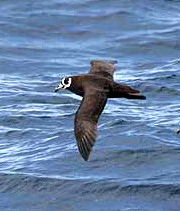|
Spectacled Petrel (Procellaria conspicillata) - Wiki
| 제목: | Spectacled Petrel (Procellaria conspicillata) - Wiki
| |

| 해상도: 180x211
파일크기: 19989 Bytes
촬영일: 2007:12:12 15:41:13
등록시간: 2007:12:12 15:42:24
|
Spectacled Petrel
From Wikipedia, the free encyclopedia
Order: Procellariiformes
Family: Procellariidae
Synonyms: Procellaria aequinoctialis conspicillata
The Spectacled Petrel, Procellaria conspicillata, is a rare seabird that nests only on the high western plateau of Inaccessible Island, Tristan da Cunha. It is one of the largest petrels that nest in burrows.
The Spectacled Petrel is an all dark bird with white face markings - which vary in extent but include a ring of white feathers surrounding the eye region which give the bird it's name - and a yellowish bill. It is very similar to the White-chinned Petrel, which lacks the face markings. It was considered conspecific with that species - or even a color morph - until 2004.
The Spectacled Petrel is threatened by interactions with longline fisheries which kills hundreds of birds every year as they become entangled in the fishing lines and drown. Historically, it also seems to have occurred on Amsterdam Island and possibly elsewhere in the southern Indian Ocean, based on sightings off Australia; it was extirpated by feral pigs.
The species was classified as Critically Endangered by the IUCN in 2000. A subsequent study gave cautious hope for a continuing recovery of the population from an all-time low of merely some dozens of pairs in the 1930s. Indeed it appears as if the species' numbers have been underestimated in more recent years as an accurate census is difficult due to the rugged terrain of its island home. Consequently, the conservation status of this species is downgraded to Vulnerable in the 2007 IUCN Red List.
http://en.wikipedia.org/wiki/Spectacled_Petrel
| The text in this page is based on the copyrighted Wikipedia article shown in above URL. It is used under the GNU Free Documentation License. You may redistribute it, verbatim or modified, providing that you comply with the terms of the GFDL. |
|
^o^
동물그림창고 똑똑전화 누리집
^o^
|
|